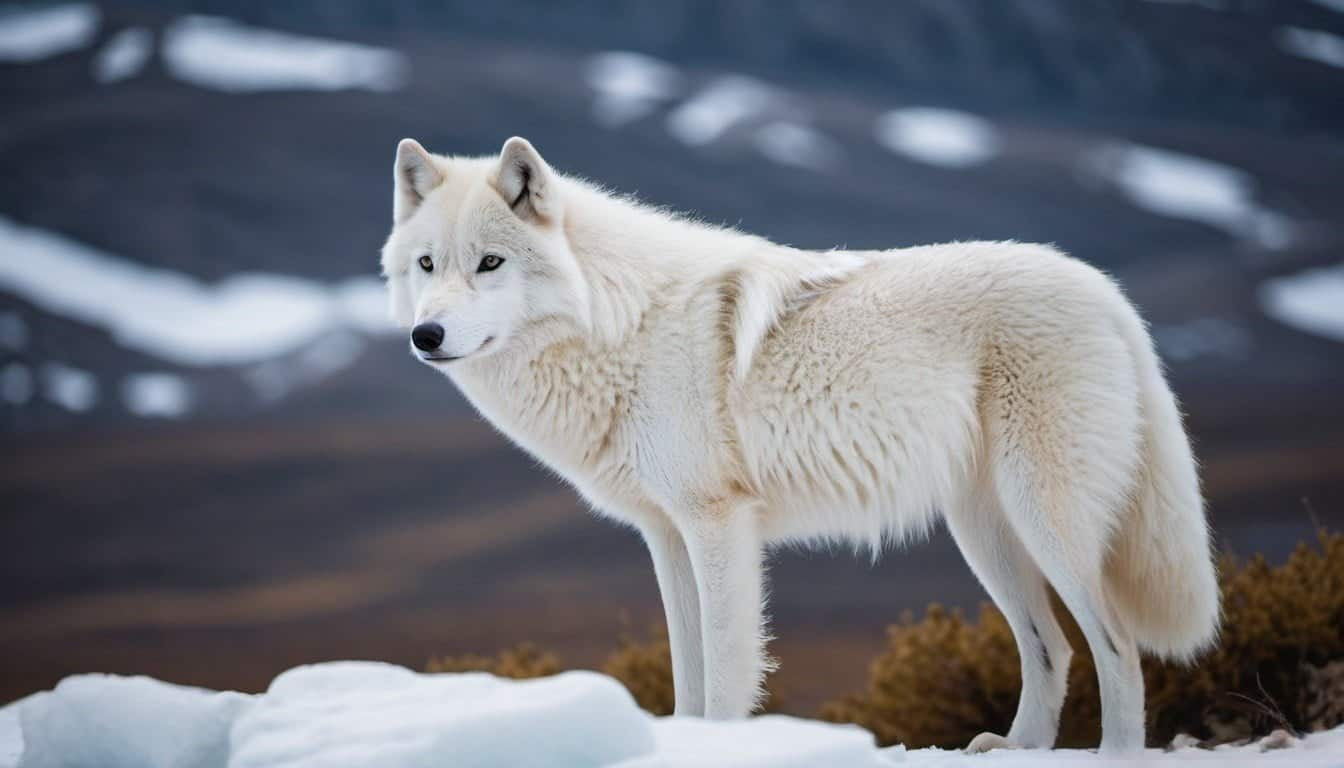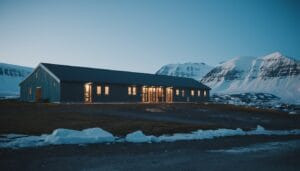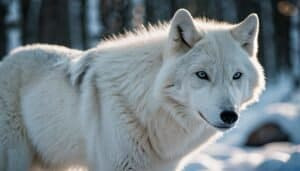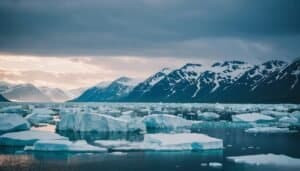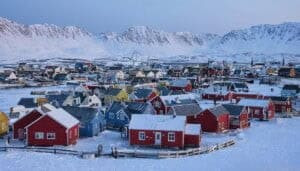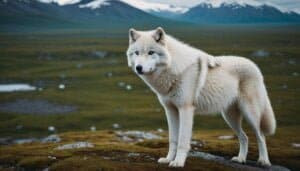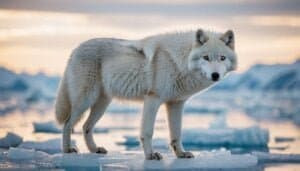Introduction
Arctic wolves are vital to the Arctic ecosystem, and their conservation has become a focal point in modern environmental efforts
This article explores the current impact of conservation initiatives on Arctic wolves, the organizations involved, and the research being conducted. It also examines how climate change is affecting these predators, the challenges faced in their conservation, and the perspectives of indigenous communities
We will discuss the future prospects for Arctic wolf populations, highlighting the role of technology and innovation in ensuring their survival
Impact of Conservation Efforts on Arctic Wolves
Conservation efforts for Arctic wolves have gained momentum in recent years, driven by the recognition of their critical role in the Arctic ecosystem. These efforts encompass various strategies and initiatives aimed at protecting and preserving Arctic wolf populations
This section explores the impact of protective legislation, conservation programs, and highlights both success stories and ongoing challenges
Protective Legislation
Protective legislation forms the backbone of conservation efforts for Arctic wolves. Numerous laws and regulations at the national and international levels have been enacted to safeguard these animals and their habitats
For instance, the Endangered Species Act (ESA) in the United States provides significant protection for Arctic wolves by designating critical habitats and implementing recovery plans. Additionally, the Convention on International Trade in Endangered Species of Wild Fauna and Flora (CITES) regulates the trade of Arctic wolves and their body parts, curbing illegal hunting and trafficking
International agreements like the Arctic Council’s Conservation of Arctic Flora and Fauna (CAFF) Working Group also play a crucial role
CAFF’s initiatives promote collaborative conservation strategies among Arctic nations, focusing on habitat preservation and biodiversity. By enforcing strict hunting regulations and habitat protection measures, these legislative frameworks help mitigate threats to Arctic wolf populations
Conservation Programs
Conservation programs are instrumental in the practical implementation of protective measures. These programs often involve partnerships between governmental bodies, non-governmental organizations (NGOs), and local communities
For example, the World Wildlife Fund (WWF) has several initiatives targeting Arctic wolf conservation. These programs focus on habitat restoration, monitoring wolf populations, and promoting coexistence between wolves and human communities
Research and monitoring programs are crucial components of these conservation efforts. By tracking Arctic wolf populations and studying their behavior, scientists can identify critical threats and develop effective strategies to address them. Initiatives like collaring and tracking wolves provide valuable data on their movements, hunting patterns, and interactions with other species, which is vital for informed conservation planning
Education and awareness campaigns are also integral to conservation programs. By educating the public about the importance of Arctic wolves and the challenges they face, these campaigns foster a sense of stewardship and encourage support for conservation initiatives
Schools, community centers, and media outlets play pivotal roles in disseminating information and engaging the public in conservation efforts
Success Stories and Challenges
Despite the significant progress made through protective legislation and conservation programs, Arctic wolf conservation faces numerous challenges. However, there are notable success stories that highlight the positive impact of these efforts
One such success story is the recovery of Arctic wolf populations in protected areas. For example, in regions where strict hunting regulations and habitat protections are enforced, wolf populations have shown signs of recovery
The establishment of wildlife reserves and national parks in Arctic regions has provided safe havens for wolves, allowing their numbers to stabilize and grow
Collaborative conservation efforts have also yielded positive results. Cross-border initiatives, such as those facilitated by the Arctic Council, have led to the creation of transboundary protected areas, ensuring that wolves can move freely across international borders without the threat of hunting or habitat loss
However, challenges persist. Climate change remains a significant threat, altering the Arctic landscape and impacting prey availability for wolves. Additionally, political and economic barriers can hinder the implementation of conservation measures. Limited funding and resources often constrain the scope and effectiveness of conservation programs, making it challenging to sustain long-term efforts
Human-wildlife conflict is another ongoing challenge. As human activities encroach on Arctic habitats, wolves increasingly come into contact with human communities, leading to conflicts over livestock predation and competition for resources
Addressing these conflicts requires innovative solutions that balance the needs of local communities with the imperative to protect Arctic wolves
Organizations and Research in Arctic Wolf Conservation
The conservation of Arctic wolves involves a concerted effort by various organizations, both governmental and non-governmental, working together to protect these vital predators. Research plays a critical role in informing and guiding conservation strategies, making it a cornerstone of efforts to ensure the survival of Arctic wolves
Governmental Bodies
Governmental bodies at the national and international levels are crucial in setting policies and regulations that protect Arctic wolves
In the United States, the U.S. Fish and Wildlife Service (USFWS) is a key player in Arctic wolf conservation. The USFWS enforces the Endangered Species Act, which includes measures to protect Arctic wolves and their habitats. Similarly, in Canada, the Canadian Wildlife Service (CWS) oversees conservation efforts for Arctic wildlife, including wolves
Internationally, the Arctic Council, composed of eight Arctic nations, plays a significant role. The Conservation of Arctic Flora and Fauna (CAFF) Working Group within the Arctic Council coordinates efforts to preserve the Arctic environment and its species, including Arctic wolves
These governmental bodies work together to harmonize conservation policies, share research findings, and implement joint initiatives
Non-Governmental Organizations
Non-governmental organizations (NGOs) are pivotal in the practical implementation of conservation strategies
The World Wildlife Fund (WWF) is one of the most prominent NGOs involved in Arctic wolf conservation. The WWF’s Arctic Programme works on habitat protection, mitigating human-wildlife conflict, and promoting sustainable development in Arctic regions
Another important NGO is the Wildlife Conservation Society (WCS), which conducts research and conservation projects aimed at understanding and protecting Arctic wolves. The WCS focuses on long-term ecological monitoring, providing crucial data that informs conservation policies and practices
Local NGOs and indigenous organizations also play essential roles. These groups often have a deep understanding of the local ecology and traditional knowledge, which can be invaluable for conservation efforts
They work on the ground to implement conservation measures, engage local communities, and advocate for policy changes
Collaborative International Efforts
Collaborative international efforts are vital for the effective conservation of Arctic wolves, given the transboundary nature of their habitat
The Circumpolar Biodiversity Monitoring Program (CBMP), an initiative of CAFF, is one such effort. The CBMP aims to monitor and assess biodiversity in the Arctic, including the status and trends of Arctic wolf populations
The International Union for Conservation of Nature (IUCN) also plays a role through its Arctic Specialist Group, which brings together experts to address conservation challenges in the Arctic. This group provides scientific advice, develops conservation guidelines, and facilitates international cooperation
Additionally, collaborative projects like the Arctic Wolves Research and Conservation Initiative (AWRCI) focus on cross-border research and conservation. These initiatives promote the sharing of data, resources, and expertise among countries, enhancing the overall effectiveness of conservation efforts
Ongoing Research Projects
Research is fundamental to understanding Arctic wolves and developing effective conservation strategies
Ongoing research projects often involve tracking and monitoring wolf populations to gather data on their movements, behavior, and interactions with other species. For example, satellite collaring projects allow scientists to follow the movements of individual wolves, providing insights into their hunting patterns, territory use, and migration routes
Studies on prey availability and habitat use are also critical. By understanding the ecological needs of Arctic wolves, researchers can identify key areas for protection and restoration. This research helps inform habitat management plans and conservation priorities
Genetic research is another important area. Analyzing the genetic diversity of Arctic wolf populations can reveal information about their health, resilience, and adaptability to changing environmental conditions. This knowledge is crucial for developing strategies to maintain genetic diversity and prevent inbreeding
Technological Advancements
Technological advancements have revolutionized the field of wildlife conservation
Innovations such as remote sensing, drone technology, and advanced data analytics are providing new tools for studying and protecting Arctic wolves. Remote sensing technology, for example, allows scientists to monitor changes in the Arctic landscape and assess the impact of environmental changes on wolf habitats
Drones are being used to conduct aerial surveys, providing detailed images and data on wolf populations and their habitats. These surveys are less intrusive and more cost-effective than traditional methods, enabling more frequent and comprehensive monitoring
Advanced data analytics, including machine learning and artificial intelligence, are helping researchers analyze large datasets collected from tracking devices, camera traps, and other sources. These tools can identify patterns and trends that inform conservation strategies and decision-making
Community Involvement in Research
Community involvement is crucial for the success of Arctic wolf conservation
Engaging local communities, particularly indigenous peoples, in research and conservation efforts ensures that these initiatives are culturally appropriate and locally supported. Indigenous communities often possess traditional ecological knowledge that can enhance scientific research and conservation practices
Collaborative research projects that involve community members in data collection, monitoring, and decision-making foster a sense of ownership and stewardship. This participatory approach not only improves the effectiveness of conservation efforts but also builds trust and cooperation between researchers and local communities
Effects of Climate Change on Arctic Wolves
Climate change is profoundly impacting the Arctic environment, bringing about significant changes that affect all its inhabitants, including Arctic wolves. This section examines how climate change is altering wolf habitats, affecting prey availability, and increasing human encroachment in the Arctic
Changing Habitats
The Arctic is warming at a rate more than twice the global average, leading to dramatic changes in its landscapes. Melting ice and permafrost are transforming the habitat that Arctic wolves depend on. As the ice retreats, it alters the distribution of both the wolves and their prey
For example, the reduction in sea ice affects the availability of seals, a primary food source for Arctic wolves in coastal areas. Wolves are forced to adapt by seeking alternative prey or moving to different regions, which can lead to increased competition with other predators and additional stress on their populations
The loss of permafrost also impacts denning sites. Arctic wolves rely on stable, frozen ground to create dens for raising their young
Thawing permafrost can collapse these dens, making it more difficult for wolves to find suitable places to breed and rear their pups. This disruption can lead to lower reproductive success and reduced pup survival rates
Altered Prey Availability
Climate change affects the availability and distribution of prey species, which in turn impacts Arctic wolves
Changes in vegetation patterns due to warming temperatures alter the habitats of herbivores like caribou and muskoxen, which are primary prey for Arctic wolves. As these prey species migrate to find suitable grazing areas, wolves must follow, often traveling greater distances and expending more energy
Additionally, warmer temperatures can lead to population booms in certain prey species, followed by crashes
For example, increased plant growth during warmer periods can initially support larger populations of herbivores, but if these conditions are followed by harsh winters or other climatic extremes, prey populations can plummet, leaving wolves with insufficient food
Climate change also affects the timing of seasonal events, such as the breeding and migration of prey species. Mismatches between the timing of prey availability and the wolves’ hunting and breeding cycles can further strain wolf populations. These mismatches can lead to periods of food scarcity, affecting the health and survival of both adult wolves and their pups
Increased Human Encroachment
As the Arctic becomes more accessible due to melting ice and warmer temperatures, human activities are expanding into previously untouched areas. This increased human presence brings additional threats to Arctic wolves, including habitat destruction, pollution, and direct conflicts with humans
Industrial activities such as oil and gas exploration, mining, and infrastructure development can fragment and degrade wolf habitats. Roads, pipelines, and other developments create barriers to wolf movement, disrupting their natural ranges and leading to increased mortality from vehicle collisions
Pollution from these industrial activities can also impact Arctic ecosystems. Contaminants like heavy metals and chemicals can accumulate in the food web, affecting both wolves and their prey. Additionally, noise pollution from machinery and transportation can disturb wolves, altering their behavior and increasing stress levels
Human encroachment also increases the likelihood of direct conflicts between wolves and people
As wolves come into closer contact with human settlements, they may prey on livestock, leading to retaliatory killing by farmers and herders. Efforts to mitigate these conflicts, such as using non-lethal deterrents and promoting coexistence strategies, are crucial to reducing the negative impact on wolf populations
Challenges in Arctic Wolf Conservation
Arctic wolf conservation faces several significant challenges that complicate efforts to protect these animals and their habitats. These challenges include funding and resource allocation, political and economic barriers, and the need for increased public awareness and education
Funding and Resource Allocation
Securing adequate funding and resources is one of the primary challenges in Arctic wolf conservation
Conservation programs often require substantial financial support to carry out research, implement protection measures, and monitor wolf populations. However, funding for wildlife conservation is limited and highly competitive, with many species and ecosystems vying for resources
Governmental agencies, non-governmental organizations, and international bodies must prioritize and allocate resources efficiently to ensure that Arctic wolf conservation initiatives receive the necessary support. Unfortunately, economic constraints and shifting political priorities can lead to reduced funding for environmental programs, including those focused on Arctic wolves
Additionally, the remote and harsh conditions of the Arctic make conservation efforts more costly. Logistical challenges such as transportation, equipment, and personnel expenses add to the financial burden
Innovative funding solutions, such as public-private partnerships and international grants, are essential to overcoming these financial barriers
Political and Economic Barriers
Political and economic barriers also pose significant challenges to Arctic wolf conservation
Conservation efforts often require cooperation and coordination across multiple jurisdictions, including local, national, and international levels. Political differences and competing interests can hinder collaborative conservation efforts and the implementation of consistent policies
For example, the Arctic region is home to several countries with varying environmental regulations and priorities. Coordinating conservation actions across these countries requires diplomatic efforts and agreements, which can be complicated by geopolitical tensions and economic interests in resource extraction
Economic interests, such as oil and gas exploration, mining, and commercial fishing, often conflict with conservation goals. These industries can have substantial economic influence, leading to political decisions that prioritize short-term economic gains over long-term environmental sustainability
Balancing economic development with conservation requires careful planning and strong political will to enforce regulations that protect Arctic wolves and their habitats
Public Awareness and Education
Increasing public awareness and education about Arctic wolves and the importance of their conservation is crucial for garnering support and promoting positive attitudes toward wildlife protection
However, the remote nature of the Arctic and the relatively low visibility of Arctic wolves compared to more iconic species like polar bears can make it challenging to engage the public
Education campaigns and outreach programs are essential to inform people about the role of Arctic wolves in the ecosystem, the threats they face, and the efforts needed to protect them. Schools, community organizations, and media outlets play vital roles in spreading this information and fostering a sense of responsibility and stewardship
Misconceptions and negative perceptions of wolves as threats to livestock and human safety can also hinder conservation efforts. Addressing these misconceptions through education and promoting coexistence strategies can help reduce conflicts and build public support for conservation measures
Innovative approaches, such as using social media, documentaries, and citizen science projects, can enhance public engagement and awareness
By involving the public in conservation activities, such as monitoring wolf populations or participating in habitat restoration projects, people can develop a deeper connection to Arctic wolves and a greater commitment to their protection
Indigenous Perspectives and Future Prospects
Indigenous communities in the Arctic have a profound connection to the land and its wildlife, including Arctic wolves. Their perspectives and traditional ecological knowledge are invaluable for conservation efforts
Additionally, understanding the future prospects for Arctic wolf populations involves exploring emerging conservation strategies, technological innovations, and the potential role these elements will play in ensuring their survival
Cultural Significance
Arctic wolves hold cultural significance for many indigenous communities in the Arctic
These wolves are often viewed as integral to the natural balance and are respected for their roles as hunters and guardians of the wilderness. Indigenous stories and traditions frequently include the Arctic wolf, highlighting their importance in the cultural and spiritual lives of these communities
The respect for Arctic wolves is reflected in traditional hunting practices and wildlife management. Indigenous peoples often practice sustainable hunting and have deep knowledge of the ecosystem’s dynamics. This knowledge can inform modern conservation strategies, ensuring they are culturally appropriate and effective
Traditional Ecological Knowledge
Traditional ecological knowledge (TEK) refers to the understanding and insights indigenous communities have developed over generations regarding their environment. TEK encompasses detailed knowledge of animal behavior, seasonal patterns, and ecological relationships. This knowledge is particularly valuable in the context of Arctic wolf conservation
For instance, indigenous communities can provide information on historical wolf populations, changes in their behavior, and shifts in prey availability
TEK can also reveal the impacts of climate change observed over long periods, offering insights that complement scientific research. Collaborating with indigenous communities to integrate TEK into conservation planning can enhance the effectiveness and sustainability of these efforts
Collaborative Conservation Efforts
Collaborative conservation efforts involving indigenous communities are essential for the success of Arctic wolf conservation
These efforts recognize the rights and contributions of indigenous peoples and ensure their participation in decision-making processes. Such collaborations can lead to more holistic and inclusive conservation strategies
Co-management agreements are one example of successful collaboration. These agreements involve shared responsibility for wildlife management between government agencies and indigenous communities. By working together, they can develop and implement conservation measures that respect indigenous knowledge and practices while achieving conservation goals
Education and capacity-building initiatives are also crucial. Providing training and resources to indigenous communities enables them to take an active role in conservation projects. This empowerment fosters a sense of ownership and stewardship, enhancing the long-term sustainability of conservation efforts
Predicted Population Trends
Predicting the future population trends of Arctic wolves requires a comprehensive understanding of the factors influencing their survival. Climate change, prey availability, and human activities all play significant roles in determining the trajectory of wolf populations
Models that incorporate climate projections suggest that Arctic wolves will face increasing challenges as their habitats continue to change
However, effective conservation measures, such as protected areas and sustainable hunting practices, can help mitigate some of these impacts. Monitoring and adaptive management will be essential to respond to changing conditions and ensure the resilience of wolf populations
Emerging Conservation Strategies
Emerging conservation strategies focus on innovative approaches to protect Arctic wolves. Habitat connectivity, for example, is a key strategy
Ensuring that wolves can move freely between different regions is critical for maintaining genetic diversity and allowing populations to adapt to environmental changes. Creating corridors and protected areas that link habitats can support this connectivity
Community-based conservation is another promising strategy. By involving local communities in conservation efforts, these initiatives leverage local knowledge and promote sustainable practices. Programs that combine traditional and scientific knowledge can address conservation challenges more effectively
Technological advancements also play a role in emerging strategies. Remote sensing, satellite tracking, and data analytics provide new tools for monitoring wolf populations and their habitats. These technologies can enhance our understanding of wolf behavior and inform targeted conservation actions
Role of Technology and Innovation
Technology and innovation are transforming wildlife conservation, offering new opportunities to protect Arctic wolves
Satellite tracking collars, for instance, provide real-time data on wolf movements, allowing researchers to study their behavior and identify critical habitats. This information is crucial for developing effective conservation plans
Drones are increasingly used to monitor wildlife and habitats in remote areas. They can conduct aerial surveys, assess habitat conditions, and detect changes in the environment with minimal disturbance to the animals
Drones can also be used to locate and monitor wolf packs, providing valuable data for conservation efforts
Advanced data analytics, including machine learning and artificial intelligence, are revolutionizing the analysis of ecological data. These tools can process large datasets from various sources, identify patterns, and predict future trends. By applying these technologies, researchers can develop more accurate models of wolf populations and their responses to environmental changes
Conclusion
Arctic wolves are a crucial component of the Arctic ecosystem, and their conservation is of paramount importance
This article has examined the impact of current conservation efforts, highlighting protective legislation, the role of various organizations, and the significance of ongoing research. It has also explored the effects of climate change on Arctic wolf habitats, prey availability, and the increasing encroachment of human activities
Additionally, we discussed the challenges of funding, political and economic barriers, and the importance of public awareness and education
Indigenous perspectives and traditional ecological knowledge provide invaluable insights that enhance conservation strategies. Collaborative efforts involving indigenous communities and the integration of their knowledge into conservation planning are essential for the success of these initiatives
The future prospects for Arctic wolves depend on the implementation of emerging conservation strategies, technological advancements, and innovative approaches to habitat protection and monitoring
To ensure the long-term survival of Arctic wolves, it is crucial to continue fostering international cooperation, securing adequate funding, and engaging local communities
By combining traditional wisdom with modern science and technology, we can develop comprehensive and adaptive conservation strategies that address the multifaceted challenges facing Arctic wolves in a rapidly changing environment
